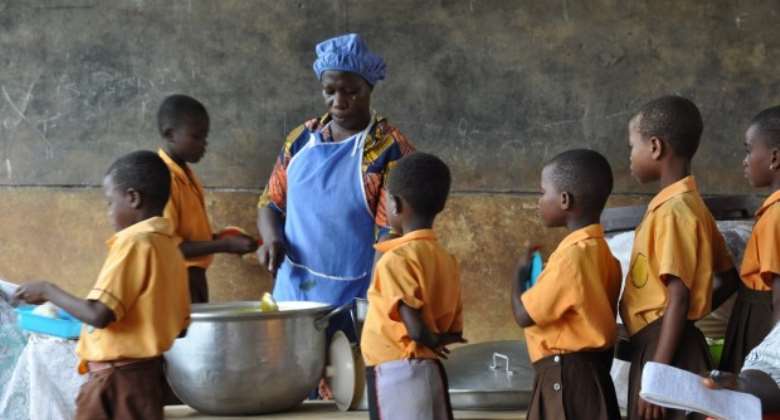Recommended
For millions of children in poor countries, a school meal means the difference between a fair chance at learning, and an empty stomach. As policymakers and experts convene in London for the Global Food Security Summit, school feeding programs continue to form the core of the social protection system in many low- and middle-income countries that have few other tools to promote child wellbeing. More than three-quarters of nearly 1,500 parents who took part in our nationally representative survey in Ghana reported they would prefer on-site school meals for their children to alternative forms of assistance such as take-home ration or equivalent cash grant.
One of the most powerful testaments to the relevance of school meals is the pace at which provision has expanded in lower-middle income countries in the years since the pandemic (Fig 1). These are relatively poor countries that have chosen to use their fiscal space to feed hungry children in school. They expanded their school meals programs by an average of 12 percent, which is three times higher than the expansion in wealthier countries. While this is an outstanding progress, it is essential to acknowledge that this growth is accompanied by a stark contrast: a 4 percent contraction in average coverage among the poorest countries, where the most vulnerable children are predominantly located.

Source: WFP 2022
The 2009 global food crisis marked the beginning of the recent wave of expansions in school feeding among developing countries. This trend emerged as national governments realized the vulnerability of their education systems to fluctuations in food supply conditions. Our world is, in many ways, more uncertain and fragile today than in 2009. As many countries struggle to preserve their spending on school meals amid severe economic headwinds, brewing geopolitical storms and an impending climate crisis, it is time to redouble our efforts to strengthen school feeding programs.
As the Global Food Security Summit gets underway, we propose three messages for stakeholders to pay heed to.
1. Free school meals from the shackles of sectoral silos
It is time to acknowledge that school feeding is a truly multi-sectoral endeavor and treat it as such in programming, budgeting and evaluation exercises. Part of the challenge of funding school feeding programs sustainably stems from the fact that the benefits of school meals accrue to various sectors that may not necessarily participate in funding them. Our analysis based on a survey of 152 school feeding programs shows that funding adequacy is positively correlated with intersectoral representation in the governance frameworks of school meals programs, particularly when budgetary decisions are not confined to a particular ministry. The silo problem seems even more pronounced in the case of aid donors who tend to force a sector-specific cost-effectiveness straitjacket on an activity that is inherently difficult to pigeonhole in a single sector.
2. Help governments deliver on their commitment to school meals
Around 98 percent of school meals are domestically funded by governments, with most of this spending included in national budgets. A recent example demonstrating the level of political commitment for these programs is the determination shown by Muhammadu Buahri’s administration in Nigeria, who legislated to bring in school feeding laws a few weeks before it was set to leave office, safeguarding against the whims of future administrations. But this does not mean that there is no role for international development partners. Oftentimes, government programs in low- and middle-income countries have little resources left to invest in ancillary activities such as capacity building and monitoring and evaluation which could improve the efficiency and effectiveness of their program. And as recent challenges precipitated by the global food price crisis show, national programs remain vulnerable to domestic and international shocks. As such, international donors could complement the efforts of national governments by strengthening their systems, building resilience and creating a safety net around fledgling programs.
3. Recognize the climate relevance of school meals
As climate change threatens global food systems, homegrown and adaptable school feeding programs could help build in resilience and contribute towards greater food security. School meals could also serve as a suitable gateway to introduce climate-friendly dietary habits. Similarly, school feeding kitchens could be leveraged to maximize the use of efficient and clean energy for cooking, reducing emissions as well as creating opportunities to raise funding through the sale of carbon credits. Moreover, school meals could be a more reliable tool to maintain school participation during potential climate emergencies than alternative assistance modalities such as general food aid. There might be instances where school meals could be preferable to emergency cash transfers, particularly because climate-related events are likely to disrupt local markets, reducing the availability or increasing the price of food that could be purchased with the cash.
The Global Food Security Summit offers a platform to champion the role of school meals in promoting child wellbeing in a world marked by conflict and uncertainty. Investing in the wellbeing of children in this way is not only a moral imperative but a strategic imperative for a better and more equitable future.
Disclaimer
CGD blog posts reflect the views of the authors, drawing on prior research and experience in their areas of expertise. CGD is a nonpartisan, independent organization and does not take institutional positions.







